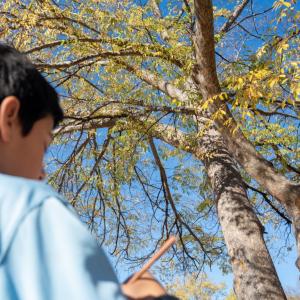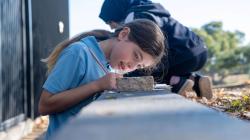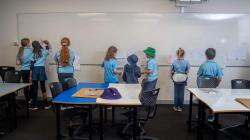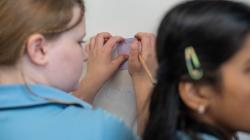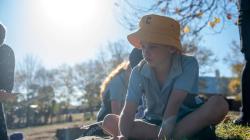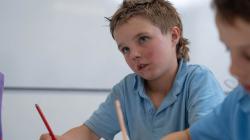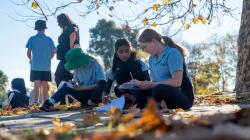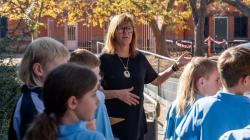'Any day outdoors' is one of our new teaching sequences for AC V9
- On the 'Sequence overview' tab you'll find all the lessons in this sequence and curriculum alignment.
- The 'Our design decisions' tab shows how key scientific ideas develop over the sequence, and shows how the sequence addresses curriculum achievement standards.
- The 'Preparing for this sequence' tab guides you through important information and considerations for this sequence.
- Have you taught this sequence? Use the Feedback button to let us know how it went!
Launch
Lesson 1 • Have a nice day
Students are introduced to the concept of daily and seasonal changes. How might the weather impact planning and participating in a picnic?
Inquire
Lesson 2 • Weather symbols
Students explore the symbols used to talk about weather and begin a daily weather chart.
Lesson 3 • Cloud cover
Students identify and describe cloud cover, explore how clouds might predict rain and consider how this can affect everyday life.
Lesson 4 • Is it hot today?
Students describe the sensations they feel when experiencing different temperatures.
Lesson 5 • Is it windy?
Students identify and describe the impact of wind and test the level of wind in different parts of the school.
Lesson 6 • Seasons
Students identify changes that occur in the world around them and classify the changes according to the length of time.
Act
Lesson 7 • Planning a picnic
Students apply their learning to predict what weather might occur during their picnic, and how they might modify their plans in response.
The Australian Academy of Science supports and encourages broad use of its material. Unless indicated below, copyright material available on this website is licensed under a Creative Commons Attribution-NonCommercial-ShareAlike 4.0 International (CC BY-NC-SA 4.0) licence.
Curriculum and syllabus alignment
Achievement standards
Students identify daily and seasonal changes and describe ways these changes affect their everyday life. They describe situations where they use science in their daily lives and identify examples of people making scientific predictions.
Students pose questions to explore observations and make predictions based on experiences. They follow safe procedures to make and record observations. They use provided tables and organisers to sort and order data and information and, with guidance, represent patterns. With guidance, they compare observations with predictions and identify further questions. They use everyday vocabulary to communicate observations, findings and ideas.
Australian Curriculum V9 alignment
Science as a human endeavour
Describe how people use science in their daily lives, including using patterns to make scientific predictions
Science understanding
Describe daily and seasonal changes in the environment and explore how these changes affect everyday life
Science inquiry
Pose questions to explore observed simple patterns and relationships and make predictions based on experiences
Sort and order data and information and represent patterns, including with provided tables and visual or physical models
Compare observations with predictions and others observations, consider if investigations are fair and identify further questions with guidance
Write and create texts to communicate observations, findings and ideas, using everyday and scientific vocabulary
Australian curriculum content links
| Science understanding core concept: Interactions between Earth’s systems cause continuous change. |
| Sub-strand | Content descriptor | AC code | Achievement Standard | How the sequence addresses this content |
| SHE: Use and influence of science | Describe how people use science in their daily lives, including using patterns to make scientific predictions. | AC9S1H01 | Describe situations where they use science in their daily lives and identify examples of people making scientific predictions. | Use their knowledge of seasons and weather to plan how to dress, what they and their pets will need for an outdoor picnic. (Lesson 7) Recognise how First Nations Australians use changes in the landscape and sky to answer questions about certain resources. (Lesson 6) |
| SU: Earth and space sciences | Describe daily and seasonal changes in the environment and explore how these changes affect everyday life. | AC9S1U02 | Identify daily and seasonal changes and describe ways these changes affect their everyday life. | Describe the impact of temperature, clouds and rain and wind. (Lessons 3, 4, 5) Compare ‘western’ seasonal calendar to Aboriginal and Torres Strait Islander Peoples Seasons. (Lesson 6)
|
| SI: Questioning and predicting | Pose questions to explore observed simple patterns and relationships and make predictions based on experiences. | AC9S1I01 | Pose questions to explore observations and make predictions based on experiences. | Predict differences in wind patterns in different parts of their school. (Lesson 5) Use their understanding to predict the weather for a specific day. (Lesson 7) |
| SI: Planning and conducting | Suggest and follow safe procedures to investigate questions and test predictions. | AC9S1I02 | Follow safe procedures. | Follow safe procedures to plan for and investigate methods to test the amount of wind around the school. (Lesson 5) |
| SI: Planning and conducting | Make and record observations, including informal measurements, using digital tools as appropriate. | AC9S1I03 | Make and record observations. | Testing wind and temperature. (Lessons 4, 5) |
| SI: Processing, modelling and analysing | Sort and order data and information and represent patterns, including with provided tables and visual or physical models. | AC9S1I04 | Use provided tables and organisers to sort and order data and information and, with guidance, represent patterns. | Collect and sort observations and data in a weather watch table. (Lessons 1-7) Use the gathered data to create decision diagrams. (Lessons 3, 4, 5)
|
| SI: Evaluating | Compare observations with predictions and others’ observations, consider if investigations are fair and identify further questions with guidance. | AC9S1I05 | Compare observations with predictions and identify further questions. | Compare observations and measurements to for temperature and clouds and wind across a day or several days. (Lessons 1-6) Compare data collected in their weather watch table to local forecasts. |
| SI: Communicating | Write and create texts to communicate observations, findings and ideas, using everyday and scientific vocabulary. | AC9S1I06 | Use everyday vocabulary to communicate observations, findings and ideas. | Compare symbols used to illustrate weather patterns. (Lesson 2) Use decision diagrams to aid in the planning for the picnic. (Lesson 7) Create a written plan that describes the predicted weather and how that will affect their planning for the picnic. (Lesson 7) |
Science journals
Create a class science journal, either in hard-copy or digitally. You might:
- use/create a large scrap book or flip chart.
- use poster/butchers’ paper so learning can be displayed in sequence on the wall.
- create a digital journal using your platform/ technology of choice.
- any combination of the above.
Plan for students’ creation of an individual science journal, either in hard-copy or digitally. They might:
- use an exercise book, scrap book or flip chart to record their thinking and gather resource sheets together.
- use a folder to store and collate resource sheets, diagrams, photographs etc.
- use a digital folder to store work samples, images and videos.
- any combination of the above.
Additional preparation
- Read through the teaching sequence.
- Prepare enlarged copies of Resource sheets as appropriate.
- Prepare and cut out the students' cards in the Natural Changes Resource sheet.
- Note any adaptations you would like to make to suit your school’s and students’ context.
- As this teaching sequence is designed around a picnic, some planning may be required, including:
- the location of the picnic.
- Depending on the location, excursion forms may need to be completed.
- the timing of the picnic.
- 30 minutes before the rest of the school start lunch is recommended.
- depending on your school, you may choose to organise an alternative event/sports day/excursion.
- the location of the picnic.
- Images and videos depicting the school at different times of the year would be useful when discussing seasonal changes.
The materials required for each lesson are listed on the lesson's page. For the full sequence resource list, download the Preparing to teach this sequence document below.
